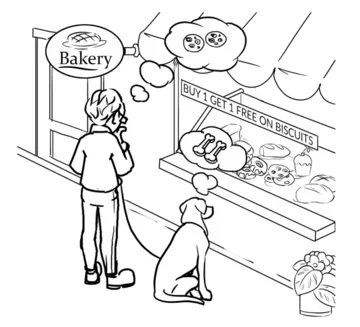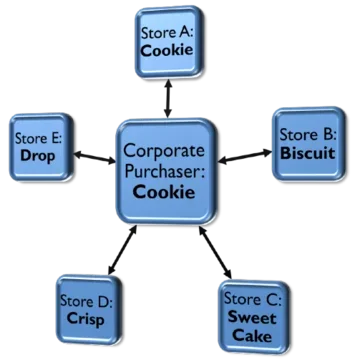In this excerpt from his book The Rosedata Stone, Applied Analytics Lecturer Steve Hoberman describes his theory of a universal business language. Hoberman is the author of nine books on data modeling, including Data Modeling Made Simple.
Imagine you are the Chief Information Officer for the bakery chain Chips Inc. Not only do you receive a salary and health benefits, but you also can eat as many pastries as you like for free from any of the 30 bakeries that Chips Inc. owns and operates. Now that is a great job perk!
Challenges

Due to the independent culture of Chips Inc. ― combined with how Chips Inc. grew by buying a bakery at a time ― each bakery has its own way of operating. Each bakery uses its own systems such as Quicken, Excel, and sometimes even pencil and paper, to assist with ordering supplies, baking pastries, managing sales, and handling payroll.
With costs for raw materials such as sugar on the rise, and increased competition from other bakeries and high-end supermarkets, Chips Inc.’s executives are looking for ways to save money and therefore increase profits. One way is the potential savings in centralizing pastry purchasing followed by a centralized payroll. Centralizing business processes such as purchasing should not only save money, but also allow for more consistent reporting across the organization, identifying additional ways to save money and uncovering new business opportunities.
Centralizing business processes such as purchasing should not only save money, but also allow for more consistent reporting across the organization."
In addition, Chips Inc. would like to franchise their brand, recipes, and processes to other bakeries. Prior to approaching bakeries on franchising opportunities, Chips Inc. needs to follow more consistent practices across their 30 stores. Once consistent practices are in place, they can be applied to the franchisee bakeries.
The executive team is convinced―mostly due to a one-hour sales pitch presentation from a large software consulting organization―that centralizing business processes will take minimal effort. The presenter touted his software solution as a seamless way to integrate all Chips Inc. processes. “It’s as easy as baking a cookie,” this software consultant said as the executives nodded their heads in hypnotic agreement. You, however, are not as optimistic. And it’s not just because you find baking a challenge. You wonder how a software solution can magically solve a very complex business problem.
After lunch you stroll down the road to Chips Inc.'s flagship bakery to treat yourself to a free chocolate chip cookie. After showing the store employee your Chips Inc. badge and receiving your free cookie, you browse the tantalizing cakes, cupcakes, and cookies.
You wonder how a software solution can magically solve a very complex business problem."
As an attempt to convince yourself of the similarity across bakeries, you decide to take a bus ride to another Chips Inc. bakery on the other side of town within an upscale neighborhood. Since this bakery caters to a higher-end clientele, what was called a cookie at the last bakery is called a biscuit in this bakery. This bakery has an extensive pie selection yet no cakes. They also sell parfaits, smoothies, and artisan breads which the first bakery did not carry.
As you munch on a free chocolate chip biscuit (which tastes strikingly similar to a chocolate chip cookie), questions start brewing:
- How do cookies and biscuits differ?
- How do pies and cakes differ?
- Are artisan breads, smoothies, and parfaits within the scope of the pastry purchasing initiative?
Successfully purchasing ingredients for our bakeries requires a common set of terms. Asking the first bakery how much sugar they order for biscuits and the second bakery how much sugar they order for cookies would most likely cause confusion as the first bakery calls them cookies and the second biscuits. In addition, a third bakery sells dog biscuits which have different ingredients and therefore different purchasing requirements than the biscuits from the second bakery.
Successfully purchasing ingredients for our bakeries requires a common set of terms."
Note that it is ok for the first bakery to keep calling them cookies and for the second bakery to keep calling them biscuits, if they are recognized by the corporate purchaser to be the same thing. This will require a common term that disambiguates all of the variations. Similar to the Rosetta Stone translating between ancient scripts, the Rosedata Stone translates between terms from different departments or locations. For example, Bakery A calls it cookie, Bakery B calls it biscuit, other bakeries have their own terms, and the corporate purchaser calls it cookie. The corporate purchaser would be the common term across the bakeries.
The corporate purchaser’s Cookie is the common term and the mapping on the facing page provides the purchaser with a translation to each of the localized terms. Determining a centralized order for sugar requires the purchaser to use the term Biscuit when communicating with Store B and Sweet Cake with Store C.
Rosedata Stone Mapping

This type of mapping is very useful for showing a common term and its translation to the multi-language reality of our current environment.
Chips Inc. executives, for example, believes centralizing purchasing will be easy without realizing that each bakery speaks their own unique language. Or maybe management acknowledges the lack of a Common Business Language but assumes a software solution will magically solve the problems. It does not matter, though, if the two bakeries you visited that day both use the same system such as Microsoft Excel, if one bakery calls it cookie and the other biscuit, there are going to be challenges in centralizing purchasing.
This article is excerpted from The Rosedata Stone by Steve Hoberman.
The views expressed are those of the author and do not necessarily represent the views of any other person or entity.
